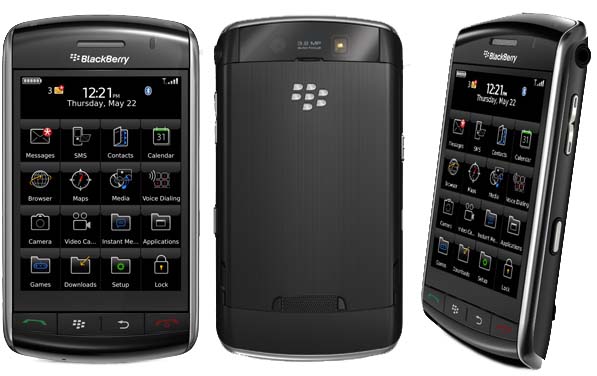
Site Sponsors:









BlackBerry StormFirst BlackBerry with a touchscreen

The BlackBerry Storm has a footprint that's almost the same that as the iPhone (4.43 x 2.45 inches vs. 4.5 x 2.35 inches). It is a fraction of an inch thicker at 0.55 inches versus a bit under half an inch for the iPhone and at 5.5 ounces weighs a bit more. And since Apple decreed that elegant smartphones must be black and silver, RIM followed suit with an attractive body design that's matte black in the front and brushed metal black in the back. A silvery trim accent separates the front and back. In terms of specifications, ever since the release of the iPhone, the design goal for everyone else has been to offer a bit more whenever possible. So while the iPhone's highly touted and razor-sharp 3.5-inch display offers 480 x 320 pixel resolution, RIM trumped that by giving the Storm a 480 x 360 pixel screen. So the resolution is a bit higher and the display a bit sharper yet, especially since the Storm's display is slightly smaller (3.25 inches diagonally). That's 184 pixel per inch resolution, beating the iPhone's 163 dpi (but not the HTC Touch Diamond's 260 dpi). An ambient light sensor automatically adjusts backlighting. And while touch had fallen from grace with phones prior to Apple's entry, everyone is now offering touch as well. The Storm is RIM's first-ever touch screen device. With RIM being a major player, and one with a long history of innovation, they had to offer something special, and so, according to RIM, the Storm includes "revolutionary touch-screen technology that dramatically enhances the touch interface and enables easy and precise typing. The world's first "clickable" touch-screen responds much like a physical keyboard and also supports single-touch, multi-touch and gestures for intuitive and efficient application navigation." Now what does "clickable" mean? Well, in an effort to provide actual tactile feedback, RIM designed the display so that it actually depresses a bit with a "click" when you tap a key or button. The idea is to confirm that a keyboard tap has, in fact, registered. RIM says there is also support for multi-touches, taps, slides and other touch-screen gestures for easy highlighting, scrolling, panning and zooming. With the resolution of digital camera imagers ever increasing, it is no surprise that the Storm tops the iPhone in this area as well. You get 3.2 megapixel versus 2.0 megapixel resolution, auto flash and video recording. Resolution, especially in camera phones, isn't everything, so we'll reserve judgement until we've had a chance to see actual pictures taken with the Storm. As for the rest of the tech specs, the Storm comes with 128MB of RAM and a gigabyte of built-in memory. That's only a small fraction of the iPhone's 8 and 16GB, but the Storm has a microSD card slot (for up to 16GB cards) underneath the battery whereas the iPhone is a closed system. Like most new smartphones, the Storm has built-in GPS. A powerful 528MHz processor moves things along smartly and the Storm comes with the latest 4.7 version of the BlackBerry OS. There's also -- surprise -- an accelerometer so that, like the iPhone, the Storm knows what position it is held in and can easily and automatically switch screen orientation. A removable and rechargeable 1,400mAH battery gets about six hours of talk time and a couple of weeks worth of standby. On the phone side of things, it's difficult to juggle between the various flavors of CDMA and GSM, and so RIM made the Storm dual-mode, which means that while it's a CDMA phone that supports Verizon's EV-DO Rev. A, it also supports the European 2100MHz UMTS/HSDPA system, and it can automatically switch between CDMA and GSM networks. Sadly, that does not apply in the US where carriers are quite proprietary about their US-flavor GSM systems. The Storm comes with BlueTooth, but there is no WiFi.
The Screenshot to the right shows the Storm's homescreen with all of its major applications. Here again, RIM borrows from Apple with a tile/icon layout on a black baackground. The web browser works both in portrait and landscape mode, Office documents can be handled via preloaded Documents to Go by DataViz, GPS lets you geotag photos and use BlackBerry Maps, BlackBerry Media Sync synchronizes directly with desktop iTunes, and the phone has mobile streaming capabilities (but the fineprint cautions, "when the streaming functionality is accessed via the WAP Browser, significant, additional charges may apply." Ouch!). If you're familiar with earlier BlackBerries you instantly see that this is a much more consumer-oriented user interface, to go along with the Storm's more consumer-oriented looks. The phone, of course, retains all the push email functionality RIM has been famous for since its first pagers. In addition to BlackBerry Enterprise, you can use Microsoft Exchange, Lotus Notes or the standard POP3 and IMAP4 standards. Until we get a chance to actually play with a BlackBerry Storm, the verdict is this:
Given the iPhone's overwhelming success and increasing adoption in business, RIM had to offer something similar, and that includes the iPhone "look," the iPhone's major characteristics (which include touch), and an approximation of the extent of the iPhone's capabilities. As a newer, and follow-up, product, RIM also tried to out-do Apple in some areas. We doubt that all RIM/BlackBerry users will instantly want to switch to the Storm, but for RIM it is dfinitely a good product to have in its roster.
[See Storm at the BlackBerry site] |
 For text entry, the Storm offers RIM's "SureType" keyboard layout in portrait mode. If you rotate the device, a full QWERTY keyboard becomes available in landscape mode. Unlike on the iPhone, you can cut and paste.
For text entry, the Storm offers RIM's "SureType" keyboard layout in portrait mode. If you rotate the device, a full QWERTY keyboard becomes available in landscape mode. Unlike on the iPhone, you can cut and paste.